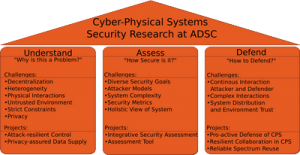Grid protectionInnovative ways to protect the smart grid
The physical infrastructure of the U.S. electric grid is aging, overburdened, and vulnerable to natural hazards. This is not the bad news. The bad news is that efforts to solve these issues have opened the door to new vulnerabilities. New approaches which transform how energy is produced, delivered, and consumed have created increased reliance on complex data flows, interconnected systems, and sophisticated technologies – that is, the new smart grid. With smarter systems, however, come equally smart hackers. To stay one step ahead of cyberattacks, engineers and scientists are exploring innovative new ways to operate and secure the grid, using the tools of game and control theory.

The vital three pillars of cybersecurity // Source: illinois.edu
The physical infrastructure of the U.S. electric grid is aging, overburdened, and vulnerable to natural hazards.
This is not the bad news.
The bad news is that efforts to solve these issues have opened the door to new vulnerabilities.
New approaches which transform how energy is produced, delivered, and consumed have created increased reliance on complex data flows, interconnected systems, and sophisticated technologies – that is, the new smart grid.
With smarter systems, however, come equally smart hackers.
Cyberattacks can come in many forms, all with the real risk of physical harm to the system. This was demonstrated in the 2007 Aurora project, in which a staged cyberattack revealed critical vulnerabilities in the power grid.
The National Science Foundation (NSF) says that to stay one step ahead of cyberattacks, engineers and scientists funded by NSF are exploring innovative new ways to operate and secure the grid, using the tools of game and control theory.
Control at the periphery
The smart grid is evolving to look like a vast ant colony, with each node of the grid collecting and acting on its own measured data. While inconsequential in isolation, those individual actions can result in collective behavior that has profound effects on the power grid as a whole.
Smart meters, smart appliances, electric vehicles, and the increasing number of devices connected through the Internet of Things offer users and grid operators new opportunities to control the usage of power at a scale never seen before.
“Essential to the reliable operation of the grid is the need to balance supply and demand on a sub-second timescale,” says Eilyan Bitar, a Cornell University engineer who designs algorithms for control of large-scale systems. “Traditionally, we schedule supply to follow demand. There is, however, a considerable flexibility in demand that remains largely untapped. So, why not tailor demand to follow supply?”
For instance, in the United States, the power grid is designed to operate at a frequency of 60 hertz. Deviations in frequency from this nominal value indicate an imbalance between supply and demand in the system.
Instead of relying entirely on large centralized generators to balance the system, your smart refrigerator could sense an imbalance between supply and demand by simply measuring the frequency of its local voltage.
